engine RENAULT KANGOO 2016 X61 / 2.G User Guide
[x] Cancel search | Manufacturer: RENAULT, Model Year: 2016, Model line: KANGOO, Model: RENAULT KANGOO 2016 X61 / 2.GPages: 173, PDF Size: 3.8 MB
Page 51 of 173
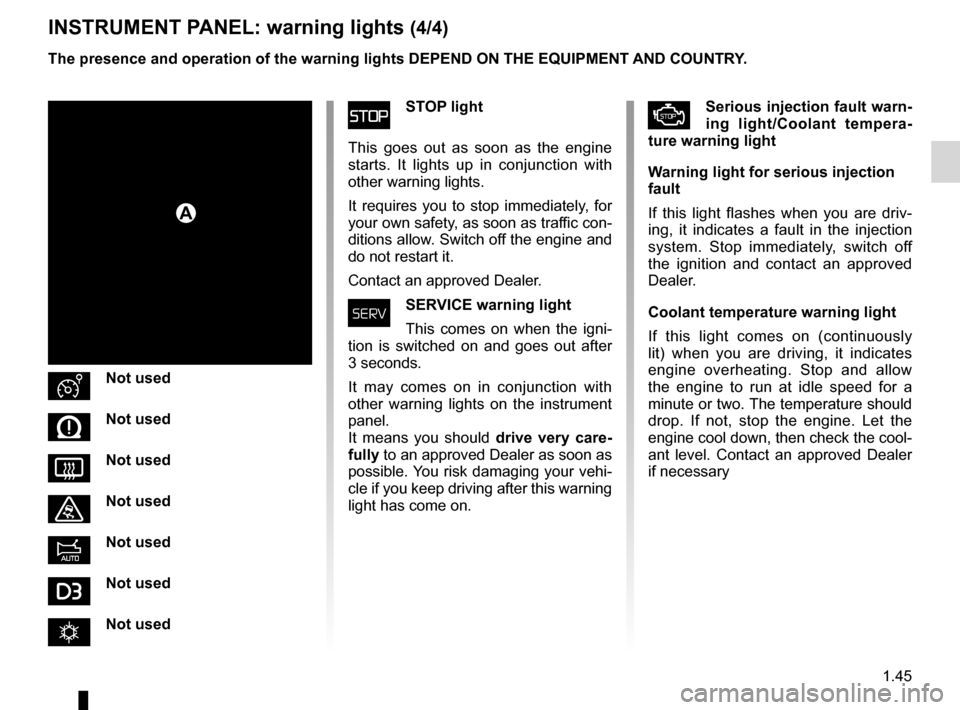
JauneNoirNoir texte
1.45
ENG_UD7264_1
Tableau de bord : témoins lumineux (X76 - Renault)
ENG_NU_854-2_X76LL_Renault_1
ûSTOP light
This goes out as soon as the engine
starts. It lights up in conjunction with
other warning lights.
It requires you to stop immediately, for
your own safety, as soon as traffic con-
ditions allow. Switch off the engine and
do not restart it.
Contact an approved Dealer.
øSER vICE warning light
This comes on when the igni-
tion is switched on and goes out after
3 seconds.
It may comes on in conjunction with
other warning lights on the instrument
panel.
It means you should drive very care-
fully to an approved Dealer as soon as
possible. You risk damaging your vehi-
cle if you keep driving after this warning
light has come on.
INSTRUMENT PANEL: warning lights (4/4)
The presence and operation of the warning lights DEPEND ON THE EQUIPMENT\
AND COUNTRY.
A
ÆSerious injection fault warn-
ing light/Coolant tempera-
ture warning light
Warning light for serious injection
fault
If this light flashes when you are driv-
ing, it indicates a fault in the injection
system. Stop immediately, switch off
the ignition and contact an approved
Dealer.
Coolant temperature warning light
If this light comes on (continuously
lit) when you are driving, it indicates
engine overheating. Stop and allow
the engine to run at idle speed for a
minute or two. The temperature should
drop. If not, stop the engine. Let the
engine cool down, then check the cool-
ant level. Contact an approved Dealer
if necessary
ÐNot used
ENot used
VNot used
ùNot used
HNot used
ïNot used
ÑNot used
Page 52 of 173
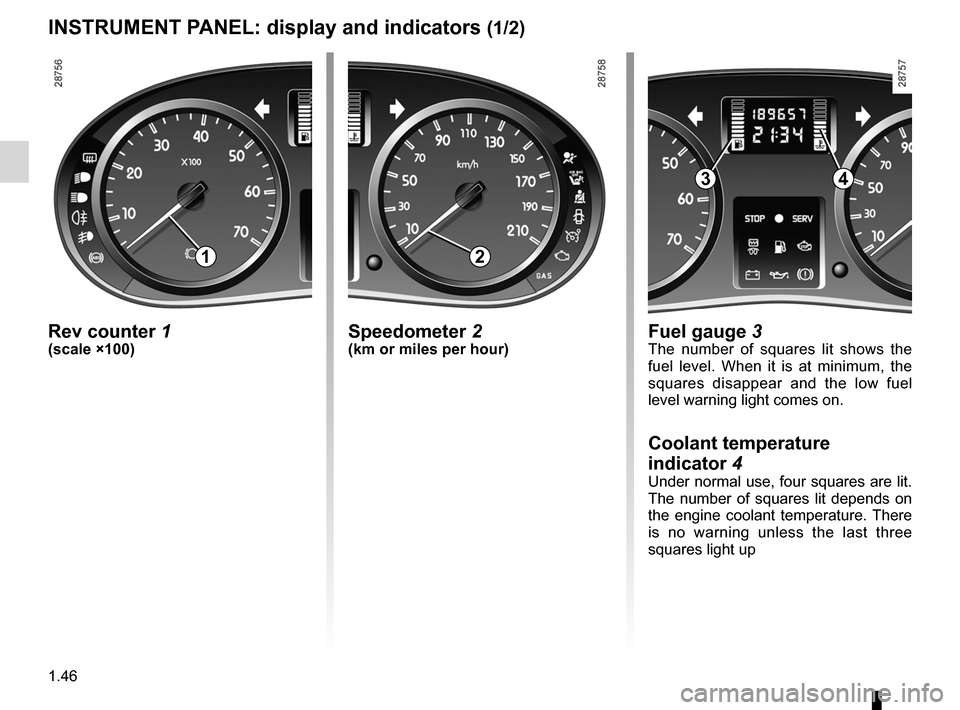
1.46
ENG_UD7265_1
Tableau de bord : afficheurs et indicateurs (X76 - Renault)
ENG_NU_854-2_X76LL_Renault_1
Jaune NoirNoir texte
Rev counter 1(scale ×100)
INSTRUMENT PANEL: display and indicators (1/2)
Speedometer 2(km or miles per hour)
12
Fuel gauge 3The number of squares lit shows the
fuel level. When it is at minimum, the
squares disappear and the low fuel
level warning light comes on.
Coolant temperature
indicator
4
Under normal use, four squares are lit.
The number of squares lit depends on
the engine coolant temperature. There
is no warning unless the last three
squares light up
34
Page 53 of 173
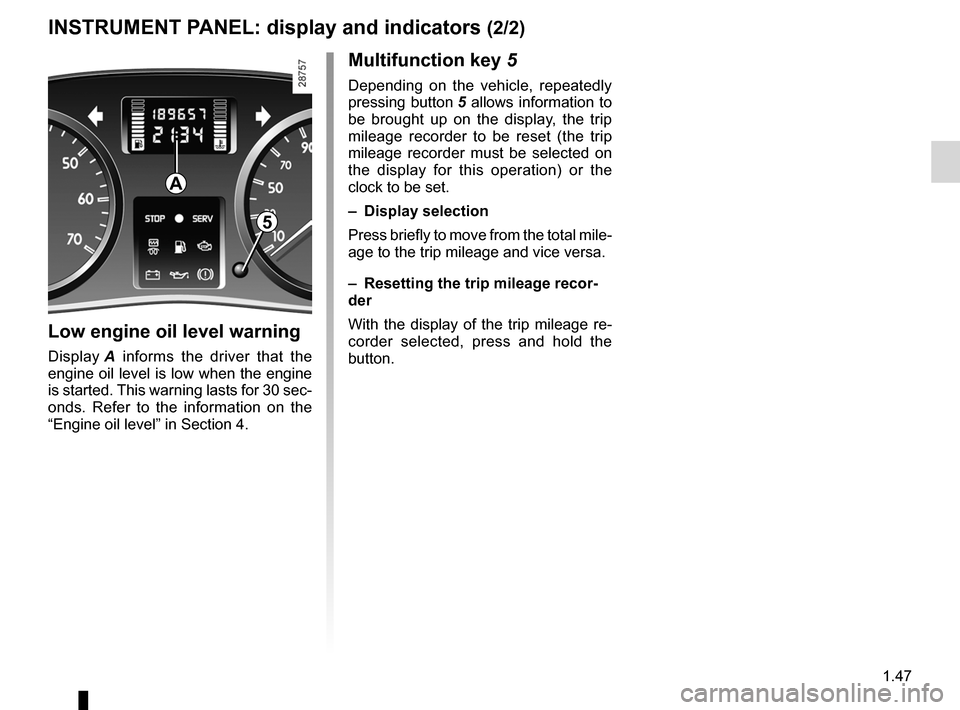
JauneNoirNoir texte
1.47
ENG_UD7265_1
Tableau de bord : afficheurs et indicateurs (X76 - Renault)
ENG_NU_854-2_X76LL_Renault_1
Multifunction key 5
Depending on the vehicle, repeatedly
pressing
button 5 allows information to
be brought up on the display, the trip
mileage recorder to be reset (the trip
mileage recorder must be selected on
the display for this operation) or the
clock to be set.
–
Display selection
Press briefly to move from the total mile-
age to the trip mileage and vice versa.
–
Resetting the trip mileage recor-
der
With the display of the trip mileage re-
corder selected, press and hold the
button.
INSTRUMENT PANEL: display and indicators (2/2)
5
Low engine oil level warning
Display A informs the driver that the
engine oil level is low when the engine
is started. This warning lasts for 30 sec-
onds. Refer to the information on the
“Engine oil level” in Section 4.
A
Page 60 of 173
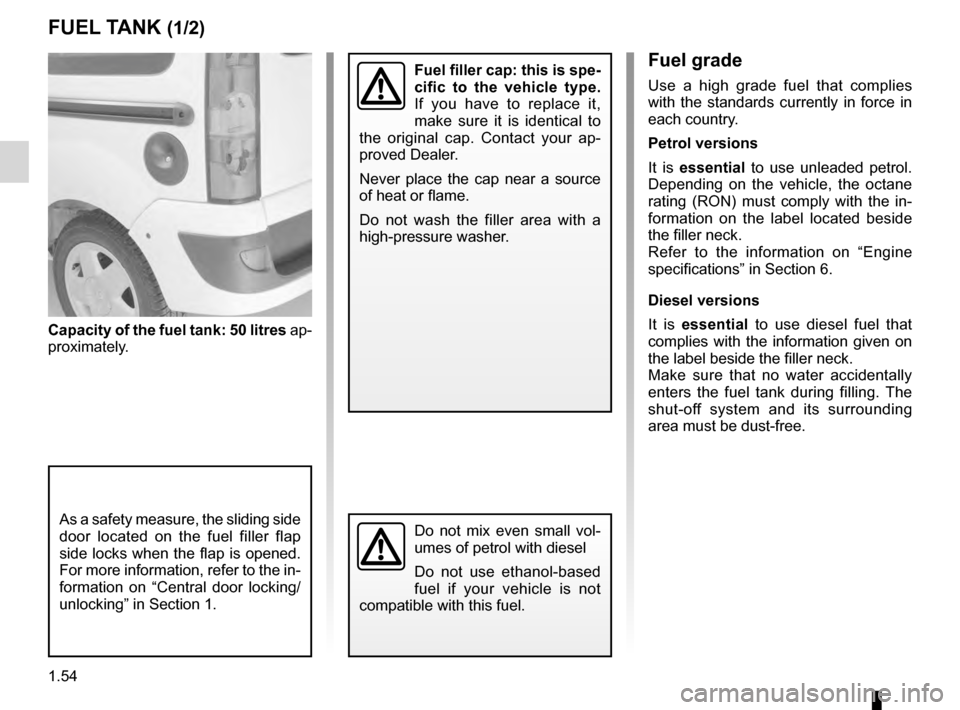
fuel filler cap ......................................... (up to the end of the DU)
fuel tank capacity .................................. (up to the end of the DU)
fuel tank capacity ........................................... (up to the end of the DU)
1.54
ENG_UD14016_2
Réservoir carburant (X76 - Renault)
ENG_NU_854-2_X76LL_Renault_1
Jaune NoirNoir texte
Fuel grade
Use a high grade fuel that complies
with the standards currently in force in
each country.
Petrol versions
It is essential to use unleaded petrol.
Depending on the vehicle, the octane
rating (RON) must comply with the in-
formation on the label located beside
the filler neck.
Refer to the information on “Engine
specifications” in Section 6.
Diesel versions
It is essential to use diesel fuel that
complies with the information given on
the label beside the filler neck.
Make sure that no water accidentally
enters the fuel tank during filling. The
shut-off system and its surrounding
area must be dust-free.
Capacity of the fuel tank: 50 litres
ap-
proximately.
Fuel tank
Do not mix even small vol-
umes of petrol with diesel
Do not use ethanol-based
fuel if your vehicle is not
compatible with this fuel.
Fuel filler cap: this is spe-
cific to the vehicle type.
If you have to replace it,
make sure it is identical to
the original cap. Contact your ap-
proved Dealer.
Never place the cap near a source
of heat or flame.
Do not wash the filler area with a
high-pressure washer.
FUEL TANK (1/2)
As a safety measure, the sliding side
door located on the fuel filler flap
side locks when the flap is opened.
For more information, refer to the in-
formation on “Central door locking/
unlocking” in Section 1.
Page 61 of 173
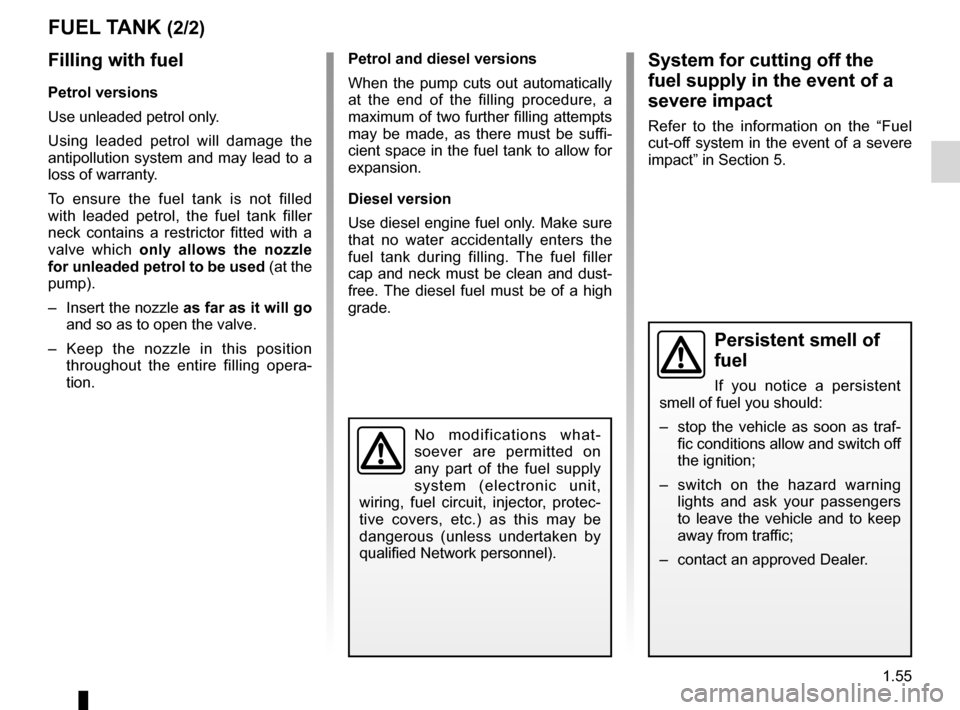
JauneNoirNoir texte
1.55
ENG_UD14016_2
Réservoir carburant (X76 - Renault)
ENG_NU_854-2_X76LL_Renault_1
Petrol and diesel versions
When the pump cuts out automatically
at the end of the filling procedure, a
maximum of two further filling attempts
may be made, as there must be suffi-
cient space in the fuel tank to allow for
expansion.
Diesel version
Use diesel engine fuel only. Make sure
that no water accidentally enters the
fuel tank during filling. The fuel filler
cap and neck must be clean and dust-
free. The diesel fuel must be of a high
grade.System for cutting off the
fuel supply in the event of a
severe impact
Refer to the information on the “Fuel
cut-off system in the event of a severe
impact” in Section 5.
Filling with fuel
Petrol versions
Use unleaded petrol only.
Using leaded petrol will damage the
antipollution system and may lead to a
loss of warranty.
To ensure the fuel tank is not filled
with leaded petrol, the fuel tank filler
neck contains a restrictor fitted with a
valve which only allows the nozzle
for unleaded petrol to be used (at the
pump).
–
Insert the nozzle as far as it will go
and so as to open the valve.
–
Keep the nozzle in this position
throughout the entire filling opera-
tion.
FUEL TANK (2/2)
No modifications what -
soever are permitted on
any part of the fuel supply
system (electronic unit,
wiring, fuel circuit, injector, protec-
tive covers, etc.) as this may be
dangerous (unless undertaken by
qualified Network personnel).
Persistent smell of
fuel
If you notice a persistent
smell of fuel you should:
–
stop the vehicle as soon as traf -
fic conditions allow and switch off
the ignition;
–
switch on the hazard warning
lights and ask your passengers
to leave the vehicle and to keep
away from traffic;
–
contact an approved Dealer.
Page 63 of 173
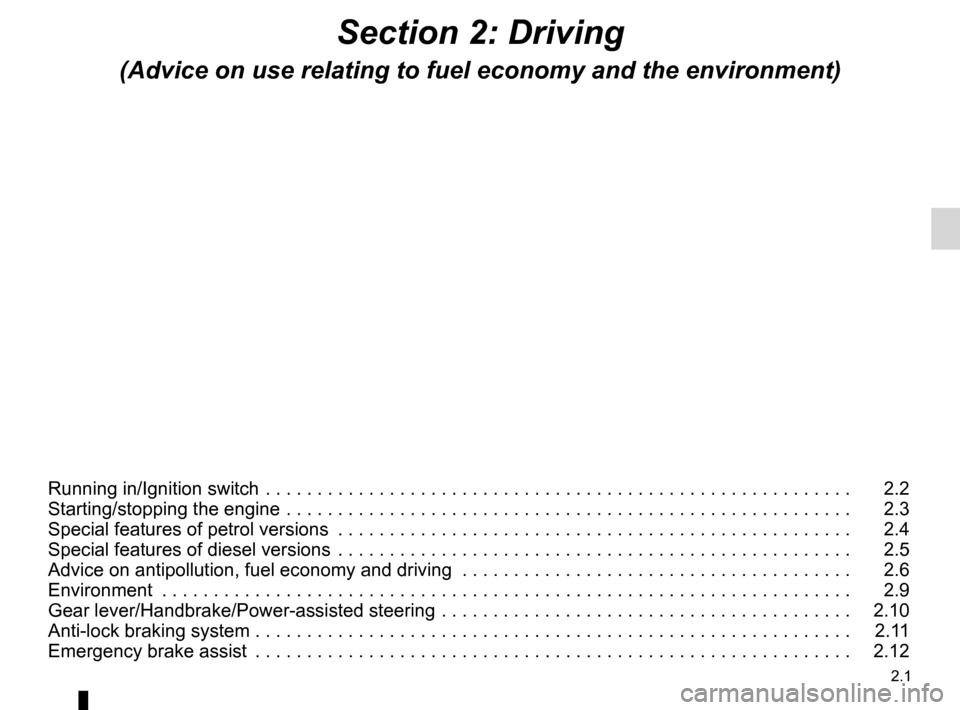
2.1
ENG_UD14019_2
Sommaire 2 (X76 - Renault)
ENG_NU_854-2_X76LL_Renault_2
Section 2: Driving
(Advice on use relating to fuel economy and the environment)
Running in/Ignition switch . . . . . . . . . . . . . . . . . . . . . . . . . . . . . . . . . . . .\
. . . . . . . . . . . . . . . . . . . . . 2.2
Starting/stopping the engine . . . . . . . . . . . . . . . . . . . . . . . . . . . . . . . . . . . .\
. . . . . . . . . . . . . . . . . . . 2.3
Special features of petrol versions . . . . . . . . . . . . . . . . . . . . . . . . . . . . . . . . . . . .\
. . . . . . . . . . . . . . 2.4
Special features of diesel versions . . . . . . . . . . . . . . . . . . . . . . . . . . . . . . . . . . . .\
. . . . . . . . . . . . . . 2.5
Advice on antipollution, fuel economy and driving . . . . . . . . . . . . . . . . . . . . . . . . . . . . . . . . . . . .\
. . 2.6
Environment . . . . . . . . . . . . . . . . . . . . . . . . . . . . . . . . . . . .\
. . . . . . . . . . . . . . . . . . . . . . . . . . . . . . . 2.9
Gear lever/Handbrake/Power-assisted steering . . . . . . . . . . . . . . . . . . . . . . . . . . . . . . . . . . . .\
. . . . 2.10
Anti-lock braking system . . . . . . . . . . . . . . . . . . . . . . . . . . . . . . . . . . . .\
. . . . . . . . . . . . . . . . . . . . . . 2.1
1
Emergency brake assist . . . . . . . . . . . . . . . . . . . . . . . . . . . . . . . . . . . .\
. . . . . . . . . . . . . . . . . . . . . . 2.12
Page 64 of 173
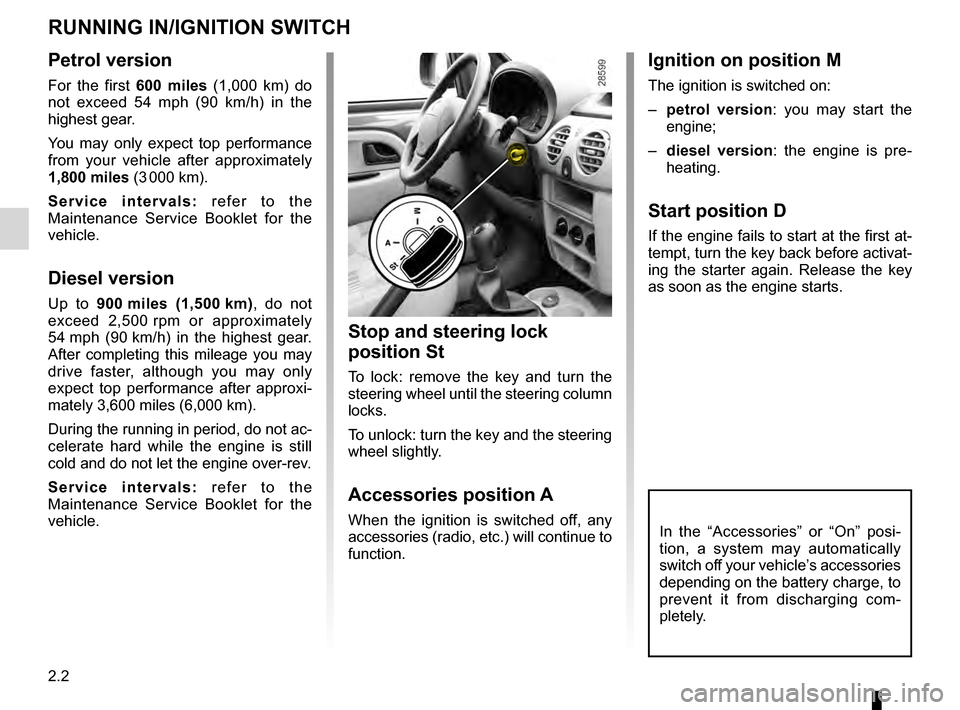
starting the engine ................................................. (current page)
running in ............................................................... (current page)
ignition switch ........................................................ (current page)
2.2
ENG_UD13969_2
Rodage / Contacteur de démarrage (X76 - Renault)
ENG_NU_854-2_X76LL_Renault_2
Running in/Ignition switch
Ignition on position M
The ignition is switched on:
– p
etrol version : you may start the
engine;
– d
iesel version : the engine is pre-
heating.
Start position D
If the engine fails to start at the first at-
tempt, turn the key back before activat-
ing the starter again. Release the key
as soon as the engine starts.
Stop and steering lock
position St
To lock: remove the key and turn the
steering wheel until the steering column
locks.
To unlock: turn the key and the steering
wheel slightly.
Accessories position A
When the ignition is switched off, any
accessories (radio, etc.) will continue to
function.
Petrol version
For the first 600 miles (1,000 km) do
not exceed 54 mph (90 km/h) in the
highest gear.
You may only expect top performance
from your vehicle after approximately
1,800 miles (3
000 km).
S e r v i c e i n t e r v a l s : r e f e r t o t h e
Maintenance Service Booklet for the
vehicle.
Diesel version
Up to 900 miles (1,500 km) , do not
e
xceed 2,500 rpm or approximately
5
4 mph (90 km/h) in the highest gear.
After completing this mileage you may
drive faster, although you may only
expect top performance after approxi-
mately 3,600
miles (6,000 km).
During the running in period, do not ac-
celerate hard while the engine is still
cold and do not let the engine over-rev.
S e r v i c e i n t e r v a l s : r e f e r t o t h e
Maintenance Service Booklet for the
vehicle.
RUNNING IN/IGNItIoN SwItch
In the “Accessories” or “On” posi-
tion, a system may automatically
switch off your vehicle’s accessories
depending on the battery charge, to
prevent it from discharging com-
pletely.
Page 65 of 173
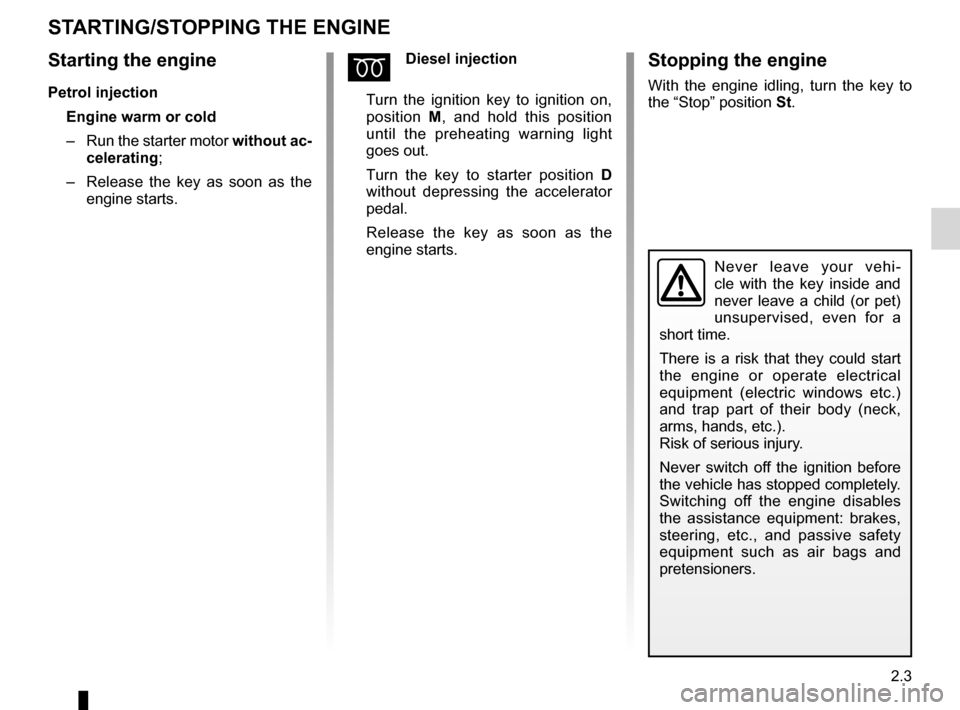
starting the engine ................................ (up to the end of the DU)
child safety............................................ (up to the end of the DU) 2.3
ENG_UD7277_1
Mise en route / Arrêt du moteur (X76 - Renault)
ENG_NU_854-2_X76LL_Renault_2
Starting/stopping the engine
Stopping the engine
With the engine idling, turn the key to
the “Stop” position St.ÉDiesel injection
Turn the ignition key to ignition on,
position M, and hold this position
until the preheating warning light
goes out.
Turn the key to starter position D
without depressing the accelerator
pedal.
Release the key as soon as the
engine starts.Starting the engine
Petrol injection
Engine warm or cold
–
Run the starter motor without ac-
celerating;
–
Release the key as soon as the
engine starts.
St ARtING/StoPPING thE ENGINE
Never leave your vehi-
cle with the key inside and
never leave a child (or pet)
unsupervised, even for a
short time.
There is a risk that they could start
the engine or operate electrical
equipment (electric windows etc.)
and trap part of their body (neck,
arms, hands, etc.).
Risk of serious injury.
Never switch off the ignition before
the vehicle has stopped completely.
Switching off the engine disables
the assistance equipment: brakes,
steering, etc., and passive safety
equipment such as air bags and
pretensioners.
Page 66 of 173
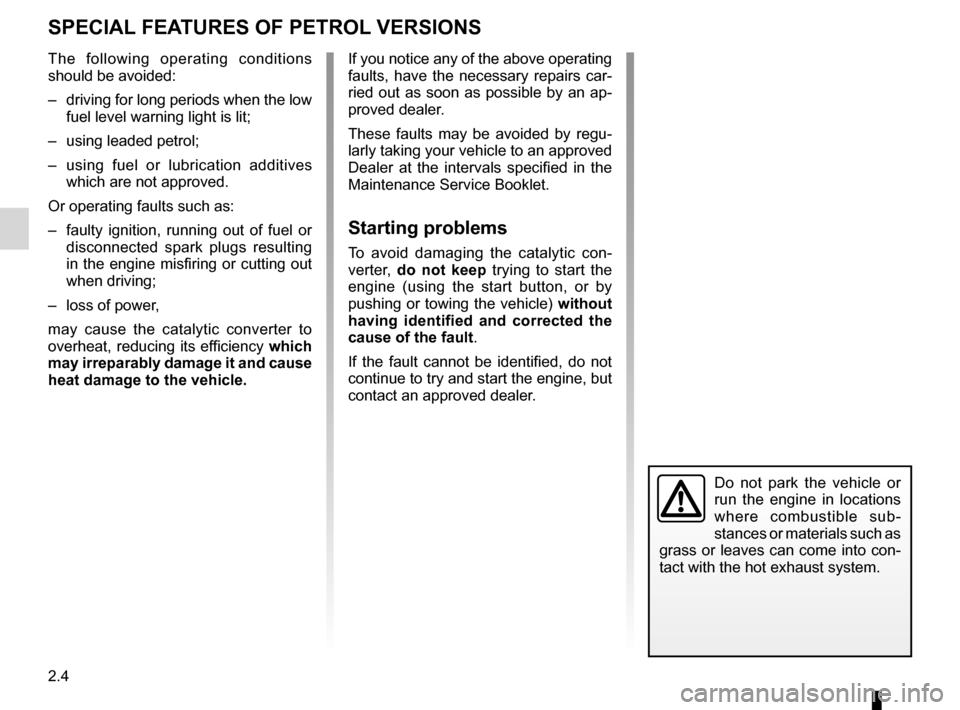
special features of petrol vehicles ........ (up to the end of the DU)
driving ................................................... (up to the end of the DU)
catalytic converter................................. (up to the end of the DU)
2.4
ENG_UD10826_1
Particularités des versions essence (X95 - J95 - R95 - Renault)
ENG_NU_854-2_X76LL_Renault_2
Special features of petrol versions
SPEcIAl fEA tURES of PEtRol vERSIoNS
Do not park the vehicle or
run the engine in locations
where combustible sub-
stances or materials such as
grass or leaves can come into con-
tact with the hot exhaust system.
The following operating conditions
should be avoided:
–
driving for long periods when the low
fuel level warning light is lit;
–
using leaded petrol;
– using fuel or lubrication additives
which are not approved.
Or operating faults such as:
–
faulty ignition, running out of fuel or
disconnected spark plugs resulting
in the engine misfiring or cutting out
when driving;
–
loss of power,
may cause the catalytic converter to
overheat, reducing its efficiency which
may irreparably damage it and cause
heat damage to the vehicle. If you notice any of the above operating
faults, have the necessary repairs car-
ried out as soon as possible by an ap-
proved dealer.
These faults may be avoided by regu-
larly taking your vehicle to an approved
Dealer at the intervals specified in the
Maintenance Service Booklet.
Starting problems
To avoid damaging the catalytic con-
verter,
do not keep trying to start the
engine (using the start button, or by
pushing or towing the vehicle) without
having identified and corrected the
cause of the fault.
If the fault cannot be identified, do not
continue to try and start the engine, but
contact an approved dealer.
Page 67 of 173
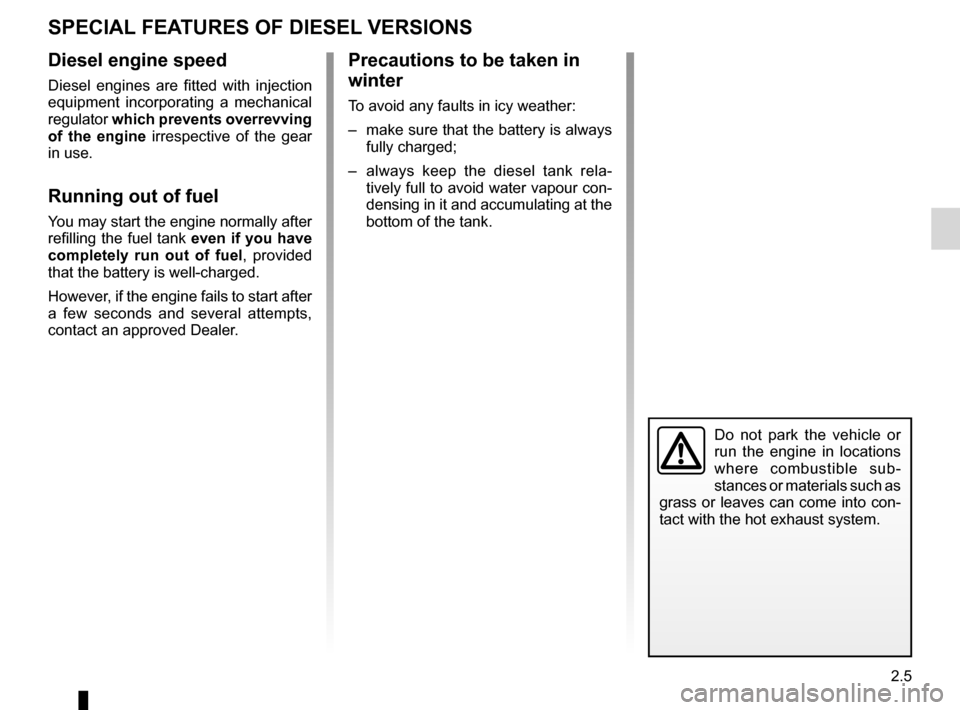
special features of diesel versions........ (up to the end of the DU)2.5
ENG_UD7279_1
Particularités versions diesel (X76 - Renault)
ENG_NU_854-2_X76LL_Renault_2
Special features of diesel versions
Do not park the vehicle or
run the engine in locations
where combustible sub-
stances or materials such as
grass or leaves can come into con-
tact with the hot exhaust system.
Precautions to be taken in
winter
To avoid any faults in icy weather:
– make sure that the battery is always
fully charged;
–
always keep the diesel tank rela -
tively full to avoid water vapour con-
densing in it and accumulating at the
bottom of the tank.
Diesel engine speed
Diesel engines are fitted with injection
equipment incorporating a mechanical
regulator which prevents overrevving
of the engine irrespective of the gear
in use.
Running out of fuel
You may start the engine normally after
refilling the fuel tank even if you have
completely run out of fuel , provided
that the battery is well-charged.
However, if the engine fails to start after
a few seconds and several attempts,
contact an approved Dealer.
SPEcIAl fEAtURES of DIESEl vERSIoNS